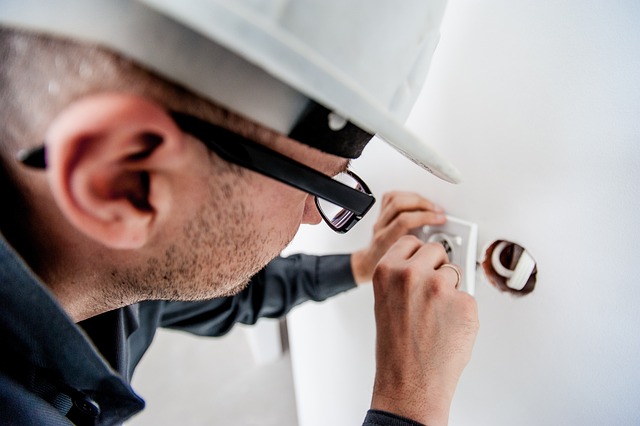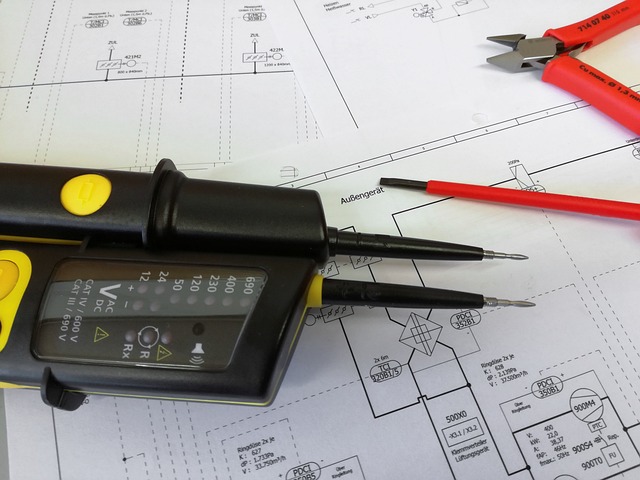Electrical components like switches, receptacles, and outlets are crucial for home safety but can degrade over time. Regular inspections can prevent costly repairs and fire risks. While minor repairs can be DIY, complex issues require professional electricians. Essential tools include wire strippers, voltage testers, and safety gear. Before replacing outlets or switches, turn off power at the breaker, test circuits, and wear protective gear. Hiring licensed, insured electricians ensures safe, code-compliant installations, energy efficiency, and peace of mind.
“Are you tired of flicking faulty switches or dealing with loose outlets? Learn how to tackle common issues with your home’s electrical fixtures head-on. This comprehensive guide navigates the repair vs. replacement dilemma, equipping homeowners with practical insights. From identifying trouble spots to ensuring safety, discover essential tools and a step-by-step process for replacing outlets and switches. Plus, explore the benefits of hiring a professional electrician when needed. Get ready to transform your home’s electrical landscape.”
- Understanding Common Issues with Switches, Receptacles, and Outlets
- When to Repair vs Replace: A Practical Guide for Homeowners
- Essential Tools and Safety Precautions for the Job
- Step-by-Step Process of Replacing Outlets and Switches
- Hiring a Professional Electrician: Benefits and Considerations
Understanding Common Issues with Switches, Receptacles, and Outlets

Switches, receptacles, and outlets are integral components of any electrical system, but like all moving parts, they can wear out or experience damage over time. Understanding common issues with these elements is a crucial first step for homeowners and business owners alike, as it enables them to identify when professional intervention, often requiring the services of an electrician, is necessary.
One frequent problem is loose connections, which can lead to flickering lights, circuit breakers tripping, or even electrical shocks. Corrosion build-up on contacts due to moisture intrusion or poor wiring techniques is another prevalent issue. Additionally, worn-out switches and receptacles may exhibit signs of overheating, burning, or melting, indicating a potential fire hazard. Identifying these issues early through regular inspections can save costly repairs and ensure the safety of occupants and property.
When to Repair vs Replace: A Practical Guide for Homeowners

As a homeowner, knowing when to repair or replace electrical components like switches, receptacles, and outlets is crucial. While minor repairs can often be tackled yourself, there comes a time when replacement is the safer option. A professional electrician is best consulted for complex issues or when the cost of repairs surpasses the price of new parts.
Consider repairing if the damage is superficial, such as burnt-out switches or loose connections easily accessible. Replacing is typically recommended for outdated components, frequent malfunctions, or signs of severe wear and tear. An electrician can assess the situation, offering expert advice tailored to your home’s unique electrical needs and ensuring safety at every step.
Essential Tools and Safety Precautions for the Job

When tackling repairs or replacements of switches, receptacles, and outlets, whether as a DIY project or under the guidance of a professional electrician, having the right tools is paramount. Basic hand tools such as wire strippers, pliers, and screwdrivers are essential for disassembling and reassembling electrical components. For more complex tasks, an adjustable wrench, voltage tester, and a multimeter can help ensure the job is done safely and effectively. These tools allow you to identify live wires, measure voltage, and test circuit continuity before proceeding, minimizing the risk of electric shock or other hazards.
Safety should always be the top priority when working with electricity. Before beginning any repair or replacement, turn off the power at the main electrical panel to isolate the circuit. Wearing protective gear, including insulated gloves and safety glasses, is crucial to safeguard against potential accidents. Additionally, keeping a fire extinguisher nearby can provide an extra layer of protection in case of unexpected electrical sparks or fires. Following these simple precautions will ensure a safer environment for both professionals and DIY enthusiasts tackling electrical work.
Step-by-Step Process of Replacing Outlets and Switches

Replacing outlets, switches, or both is a common task for many electricians, and it’s a great DIY project to tackle if you’re comfortable working with electricity. Here’s a straightforward guide:
1. Safety First: Before starting, turn off the power at your circuit breaker. Test the circuits with a voltage tester to ensure no live current flows through them. Wear safety gear, including gloves and goggles, as protection against any potential hazards.
2. Remove the Old Component: Identify the outlet or switch you wish to replace. Use a screwdriver to unscrew the mounting screws and carefully pull out the old unit. Take note of how it was wired; this will help in reconnecting later. For outlets, use a non-contact voltage detector to ensure no live wires are still attached before proceeding.
Hiring a Professional Electrician: Benefits and Considerations

When it comes to repairing or replacing switches, receptacles, and outlets, hiring a professional electrician is often the safest and most effective option. Not only do they possess the technical expertise and experience required to handle electrical work, but they also ensure compliance with local building codes and safety standards. An electrician can accurately diagnose issues, recommend the best solutions, and perform high-quality installations, minimizing the risk of future problems.
Consideration should be given to choosing a licensed and insured electrician. This guarantees that the work will be done competently and that any potential damages or accidents will be covered. Additionally, professional electricians offer peace of mind, knowing that your electrical system is in capable hands. They can also provide valuable insights into energy-efficient upgrades, helping you save money on utility bills in the long run.
When tackling issues with switches, receptacles, or outlets, homeowners can either repair or replace them, depending on the extent of the damage. While repairing might be cost-effective for minor problems, replacing is often necessary to ensure safety and long-term functionality. This article has equipped you with a comprehensive guide, from identifying common issues to hiring a professional electrician when needed. With the right tools, safety precautions, and step-by-step processes, you’re now better prepared to handle these tasks, ensuring your home’s electrical system functions optimally. Remember, for complex or uncertain situations, an experienced electrician is always a reliable solution.
